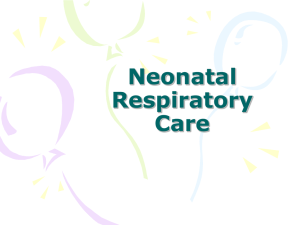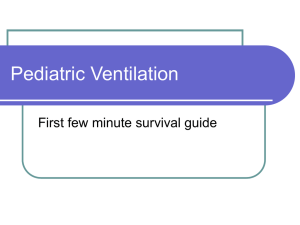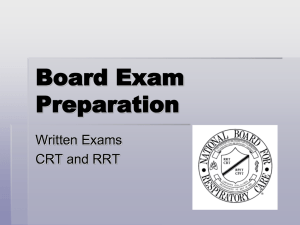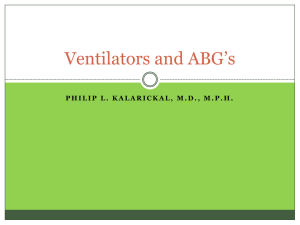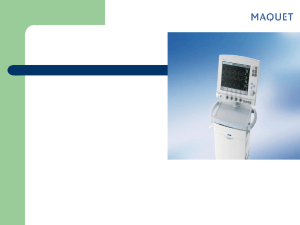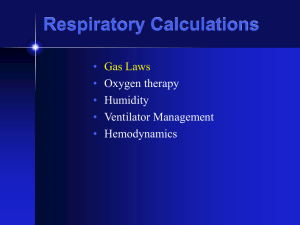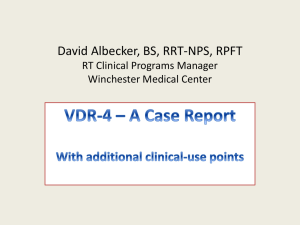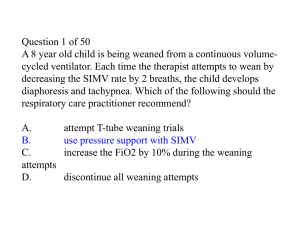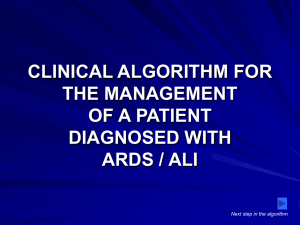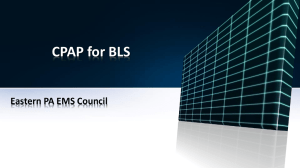Neonatal Respiratory Care - Respiratory Therapy Files
advertisement
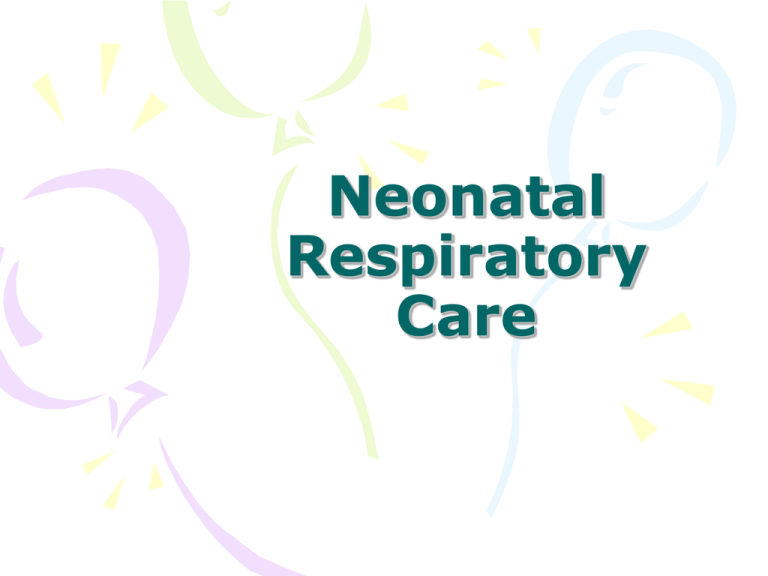
Neonatal Respiratory Care The respiratory therapist reviews the chart of a newborn and notes a 1-minute Apgar of 2 and a 5-minute Apgar of 3. For which of the following is this newborn at increased risk? I. mental impairment II. Atelectasis III. Bronchiolitis IV. first month mortality A.I and III only B.I and IV only C.II and III only D.II and IV only APGAR Score • 0 – 3 Resuscitate • 4 – 6 Support – Stimulate, warm, O2 • 7 – 10 Monitor – Routine care A 1000 g neonate who is 6 hours old is receiving time-cycled, pressure-limited ventilation. The neonate shows signs of developing RDS on a chest radiograph and severe hypoxemia is noted with an FIO2 of 0.80. Which of the following should the respiratory therapist recommend be used? A.extracorporeal membrane oxygenation B.volume-controlled ventilation C.exogenous surfactant D.nitric oxide Surfactant Administration • Beneficial to premature neonates with inadequate natural surfactant (RDS) – Preventive – Rescue • Watch for improved compliance • Be prepared to reduce ventilator settings shortly after administration Respiratory Distress Syndrome • Immature lungs with inadequate surfactant – Leads to atelectasis and hypoxemia – Leads to hyaline membrane disease • Lecithin-Sphingomyelin Ratio < 2:1 • Infants bore before 35 weeks of gestation Respiratory Distress Syndrome • Clinical Manifestations – Nasal flaring – Grunting – Retractions – Tachypnea – Cyanosis • Chest X-ray – “Ground glass” appearance – Diffuse atelectasis – Air bronchograms Respiratory Distress Syndrome • Treatment – O2 Therapy – CPAP – Mechanical Ventilation – Surfactant replacement – Thermoregulation – Adequate fluids – Packed RBCs The major component of pulmonary surfactant is A. protein. B. glucose. C. phospholipid. D. polysaccharide. After instillation of exogenous surfactant, it is expected that the patient’s lung compliance will improve. As compliance improves, the RCP should be prepared to make which of the following ventilator changes? I. Decrease pressure limit II. Decrease PEEP III.Decrease rate IV.Decrease FiO2 A. B. C. D. I I and II I, II, and III I, II, III, and IV At 1 minute after birth a neonate has the following: acrocyanosis slow, irregular respiratory effort heart rate of 102/min sneezes with the use of a nasal catheter partial flexion of the extremities The Apgar score for this neonate is A. 3. B. 5. C. 7. D. 9. APGAR Score The respiratory therapist is asked to review a newborn's history. The following information is available: What would the respiratory therapist expect to see for the 1 and 5 minute Apgar scores for this neonate? A.5,9 B.6,8 C.6,10 D.7,10 Tachypnea in the newborn is defined as a respiratory rate greater than what level? A. 40/min B. 50/min C. 60/min D. 70/min Vital Signs • Respiratory Rate: 30 – 60 bpm • Heart Rate: 120 – 160 bpm • Blood pressure: 60/40 – Preterm: 50/30 A 7-day-old neonate of 28-weeks gestational age is having frequent periods of apnea with desaturation. Which of the following should the respiratory therapist recommend? A.racemic epinephrine (Vaponefrin) B.naloxone (Narcan) C.surfactant (Survanta) D.theophylline (Aminophylline) A 34-week gestational age infant is receiving mechanical ventilation and the chest is being transilluminated. The transillumination device produces a small halo appearance at the point of contact with the skin. Which of the following does this indicate? A. pneumothorax B. pneumomediastinum C. pneumopericardium D. normal lung appearance During which of the following should apnea monitoring be implemented for an infant? I. night time II. breast feeding III. naps A. I only B. I and II only C. I and III only D. II and III only An 18-month-old infant is to receive 30% oxygen by mist tent. While performing a routine equipment check, the respiratory therapist notices the oxygen analyzer inside the tent reads 25%. After calibrating the oxygen analyzer, it still indicates 25%. The therapist should A. change oxygen analyzers. B. check the air inlet for an obstruction. C. check the oxygen inlet for an obstruction. D. add sterile water to the nebulizer reservoir. The respiratory therapist attended the birth of a full-term neonate. Vital signs are: Which of the following should be the initial treatment? A. manual ventilation with 100% O 2 B. endotracheal intubation C. oxyhood with 100% O 2 D. chest compressions Neonatal Flow Algorithm Circulation 2005;112:IV-188-IV-195 Copyright ©2005 American Heart Association During resuscitation of a newborn, after 30 seconds of positive pressure ventilation (PPV), what should the clinician do? A. Evaluate the heart rate. B. Suction the mouth, then the nose. C. Begin chest compressions. D. Initiate medications. Which of the following are indications to start CPAP for a neonate? I. Atelectasis II.Respiratory distress syndrome III.Pulmonary edema IV.Ventilatory failure A. I B. I and II C. I, II, and III D. I, II, III, and IV The decision is made to place the neonate in CPAP. Which of the following settings would you recommend to start CPAP? I. CPAP 2 cmH2O II.CPAP 5 cmH2O III.FiO2 30% IV.FiO2 60% A. I and III B. I and IV C. II and III D. II and IV CPAP • Initial Settings – Usually 4 - 7 cmH2O • • • – – – – Adjusted based on clinical assessment Increments of 1 – 2 cmH2O Observe for changes in:SpO2, Respiratory rate, WOB, Breath sounds, Blood pressure Flow 5 – 10 L/min FiO2 to maintain SpO2 > 90% ABG in 30 – 60 minutes CXR when stable to assess lung inflation 2 hours later the neonate has the following clinical presentation: HR 130, RR 30, SpO2 94%, expiratory grunting and nasal flaring continues on CPAP of 5 cmH2O and FiO2 30%. What adjustment would you recommend at this time? A.Increase CPAP by 2 cmH2O B.Increase CPAP by 4 cmH2O C.Increase FiO2 by 10% D.Intubate and mechanically ventilate 4 hours later you notice a sudden drop in the CPAP level, what could be the cause of this? A.The patient’s condition is improving B.The patient’s condition in worsening C.Disconnection D.Occlusion A patient on CPAP is demonstrating frequent apnea episodes associated with desaturation and bradycardia. Which of the following actions would you recommend? A. Increase CPAP by 2 cm H2O B. Obtain a chest x-ray and increase FIO2 C. Institute high-frequency ventilation D. Intubate and mechanically ventilate CPAP Failure • • • • Recurrent apnea or symptoms of distress Persistent acidosis (pH < 7.20) Unsatisfactory PaO2 on > 50% oxygen Consider surfactant therapy if RDS Weaning CPAP • • Decrease FiO2 < .50 Decrease CPAP in increments of 1 – 2 cmH2O Assess PaO2 with periodic ABGs Remove patient interface when: • • – – – Adequate PaO2 at lower FiO2 No signs of respiratory distress On 2 – 3 cmH2O and FiO2 < .50 Most neonatal mechanical ventilators I. provide time-triggered, pressurelimited, time-cycled ventilation. II.are pneumatically powered. III.have electrical controls and alarms. IV.feature a continuous flow of gas. A. I B. I and II C. I, II, and III D. I, II, III, and IV Increasing the inspiratory flow on a neonatal time-triggered, pressure-limited, timecycled mechanical ventilator will do which of the following? I. Increase MAP II.Increase PaO2 III.Increase PaCO2 IV.Increase tidal volume A. I and IV only B. I and II only C. II and III only D. I, II, and IV only Given the following choices, which would you select to decrease the PaCO2 in a neonate on a standard, pressure limited type ventilator? I. Increase FiO2 II.Decrease the pressure limit III.Increase the rate IV.Increase the flow V. Increase the pressure limit A. I only B. II only C. III, IV, and V D. II and III Given the following choices, which would you select to increase the PaO2 in a neonate on a standard pressure-limited type ventilator? I. Increase inspiratory time II. Increase the pressure limit III.Decrease flow IV.Increase PEEP V. Decrease the IMV rate A. B. C. D. I and V II and III III and IV I, II, and IV Meconium aspiration or other obstruction causes uneven airflow and results in which on the following? I. Hypoxemia II.Air trapping III.auto-PEEP IV.Increased risk of barotrauma A. I B. I and II C. I, II, and III D. I, II, III, and IV Meconium Aspiration Syndrome • Aspiration of meconium • Full or Post-term infants • Hypoxemia in utero, may cause the infant to pass meconium • Stress in utero causes the infant to breath deeper • Plugs airways and leads to atelectasis and increased Raw Meconium Aspiration • Plugs airways and leads to atelectasis and increased Raw • Air-trapping may lead to hyperinflation and pneumothorax • The infant may also have PDA due to intrauterine hypoxemia Meconium Aspiration • Clinical Manifestations – Hypoxemia – Hypercarbia – Tachypnea – Retractions – Nasal flaring – Grunting – Barrel chest – Course crackles and rhonchi Meconium Aspiration • Chest X-ray – Patchy infiltrates – Atelectasis – Consolidation – Pneumothorax – Hyperinflation Management of Meconium Meconium Aspiration • Treatment – Suction oral and nasal pharynx upon delivery of the head before first cry – Intubate and suction immediately after delivery – O2 Therapy – May require mechanical ventilation – CPT and Suctioning Which of the following tests are done to help confirm the diagnosis of PPHN? I. Hyperoxia test II.Preductal and postductal arterial blood sampling III.Hyperoxia-hyperventilation test IV.Echocradiography A. I B. I and II C. I, II, and III D. I, II, III, and IV PPHN Background • High pulmonary vascular resistance • Persistent Fetal Circulation (PFC) – Associated with: term or post term infants, asphyxia, meconium aspiration syndrome, congenital diaphragmatic hernia, pulmonary hypoplasia, congenital heart disease, hyaline membrane disease, pneumonia, & myocardial dysfunction. • Further right-to-left shunting PPHN Pathophysiology PPHN Clinical Manifestations • Rapidly changing oxygen saturation without changes in FiO2 • Hypoxemia out of proportion to the lung disease detected on CXR • Significant shunt through the PDA – > 5% difference between pre- and postductal SpO2 PPHN Diagnosis • Hyperioxa Test – 100% O2 for 5 – 10 minutes – PaO2 < 100 mmHg = RtL shunt • Preductal vs. postductal ABG – Preductal PaO2 15 mmHg > postductal PaO2 = RtL shunt – SpO2, TcPO2 PPHN Diagnosis cont. • Hyperoxia-hyperventilation test* – Hyperventilate • CO2: 20 – 25 mmHg • pH: > 7.50 – If PaO2 was < 50 mmHg before hyperventilation and rises to > 100 mmHg after hyperventilation = PPHN PPHN Diagnosis cont. • Echocardiogram – Increased pulmonary artery pressures – Right-to-left shunting – Tricuspid regurgitation – Right ventricular dilation PPHN Treatment • Remove the underlying cause – Oxygen for hypoxemia – Surfactant for RDS – Glucose for hypoglycemia – Inotropes for cardiac output PPHN Treatment • Hyperventilation – MV – HFV • Tolazoline – IV vasodilator • Nitric Oxide – Inhaled vasodilator • ECMO Which of the following arterial blood sampling sites are considered preductal? I. Right radial II.Left radial III.Right brachial IV.Left brachial A. I and II B. I and III C. II and IV D. III and IV What is inhaled nitric oxide? A.A surface tension reducing agent B.A pulmonary vasodilator C.A systemic vasodilator D.A bronchodilator A newborn infant is on pressure-limited, time-cycled ventilation with the following settings: PIP 20 cmH2O; rate 30/min; FiO2 0.70; PEEP 7 cmH2O; I time 0.4 sec. Umbilical artery blood gas results are: pH 7.34; PaCO2 42 mmHg; PaO2 86 mmHg. Which of the following ventilator changes would you recommend? A. Decrease rate B. Decrease PEEP C. Decrease FiO2 D. Maintain current settings Common Settings Normal Lungs Stiff Lungs Vt 6-8 ml/kg 6-8 ml/kg PIP 10-20 cmH2O 20-25 cmH2O Rate 10-20/min 20-40/min I:E 1:2 to 1:10 1:2 I time < .4 sec 0.4 – 0.7 sec PEEP 0-4 cmH2O 2-5 to 8-10 cmH2O Flow 5-8 L/min 5-8 L/min ABGs • PaO2 – Neonatal safe range: 50-70 mmHg • PaCO2 – Neonatal safe range: 35-45 mmHg – Chronic disease: <60 mmHg • pH – Neonatal safe range: 7.35-7.45 – Acceptable range: 7.30-7.50 A newborn infant has been intubated and placed on pressure-limited, time-cycled ventilation with the following settings: PIP 25 cmH2O; I time 0.4 sec; PEEP 5 cmH2O; rate 20/min; FiO2 0.60. Umbilical artery blood gas reveals: pH 7.24; PaCO2 60 mmHg; PaO2 56 mmHg; HCO3- 21 mEq/L. Which ventilator adjustment would you recommend? A. Increase PIP B. Increase rate C. Increase FiO2 D. Increase PEEP Ventilatory support parameters for an infant being weaned include: an FiO2 of 0.35; a PIP of 30 cmH2O; a PEEP of 4 cmH2O; a rate of 30/min; and an inspiratory time of 0.5 sec. Which of these parameters would you recommend trying to reduce at this time? A. FiO2 B. PIP C. PEEP D. Rate Weaning from MV • Normal ABG, adequate spontaneous respirations, increased muscle tone and activity – FiO2: wean to <0.4 in 0.2-0.5 increments – PEEP: wean to 3-4 cmH2O in 1-2 cmH2O increments – PIP: wean to 15-18 cmH2O in increments of 12 cmH2O • Failure to Wean: tachycardia, bradycardia, retractions, hypercapnia, cyanosis. Restore previous settings. Ventilatory support parameters for an infant being weaned include the following: FIO2 of 0.35; peak pressure of 18 cm H2O; positive end expiratory pressure (PEEP) level of 4 cm H2O; breathing rate of 10/min; and inspiratory time of 0.4 seconds. Assuming that blood gases are acceptable on these settings, which of the following actions would you now recommend? A. Decrease the PEEP level to 2 cm H2O. B. Decrease the breathing rate to 5/min. C. Switch the infant to 5 cm H2O CPAP. D. Increase the peak pressure to 25 cm H2O. In high-frequency oscillatory ventilation, CO2 elimination depends mainly on which of the following? A. Pressure amplitude B. Mean airway pressure C. High frequency rate D. Sinusoidal waveform The End!
